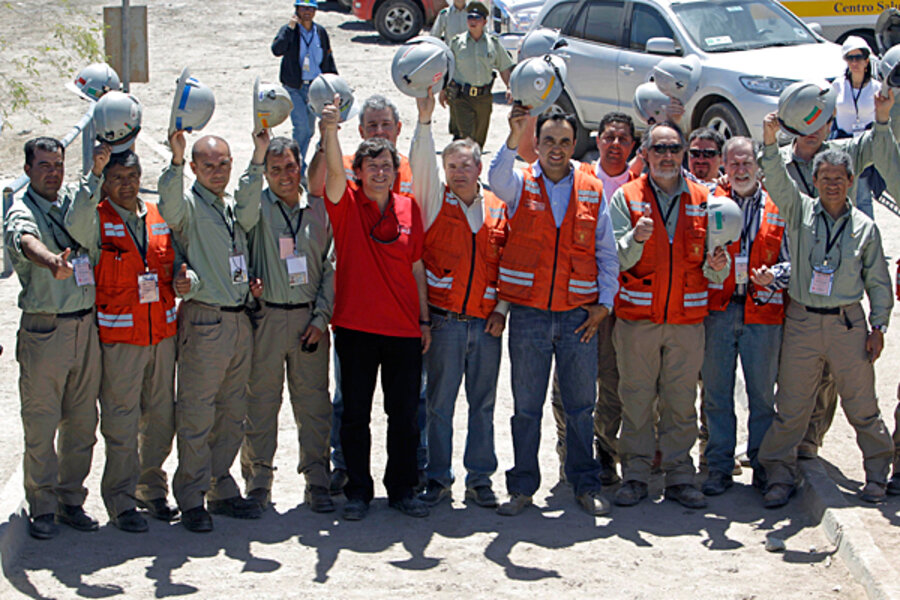Chile mine rescue spurred unprecedented global coordination
Loading...
Ten years ago, when the Russian submarine Kursk sank in the Barents Sea, what could have been a chance for the world to rally around a daring rescue was stymied by Moscow’s refusal of all international help for four days. The 118 sailors aboard survived underwater for more than two days, but ultimately drowned.
The Kursk incident returned to Russian minds this week as the Chilean government wrapped up the successful rescue of 33 miners trapped a half-mile under the Atacama Desert for the past two months.
The mantra that two heads are better than one was clearly embraced in Chile, with mining specialists from around the world descending upon the San Jose mine to assist in the rescue.
Unprecedented collaboration
"How different it was for the sailors on the Kursk," said one blogger this week. Another blogger, under an article in Gazeta.ru online newspaper, commented: "Recall Putin and Kursk... Here there are different people, a different president – and there you have the rescue."
The Chile mine rescue showed off the nation’s mining and engineering expertise, but the efforts were sped up and bolstered with international assistance, including drills and workers from Canada, NASA specialists and a 13-ton drilling tool from the United States, and a drilling consultant from Australia.
“The degree of collaboration here was exceptional, certainly, and beyond what there ever was before,” says Michael Nelson, chair of the mining engineering department at the University of Utah.
RELATED: 5 reasons the Chile mine rescue was so successful
“Something on such a kind of scale never took place before,” agrees Andrzej Wala at the University of Kentucky. “Even with all this help, it took over two months; without international help it probably would have taken much longer.”
The mining industry is increasingly advanced and interconnected, says Professor Wala, with players seeking to take advantage and utilize each other's resources. For example, a Chilean mining company can outfit its Schramm T-130 drill with a bit from Pennsylvania-based company Center Rock, Inc., as happened in the San Jose mine rescue mission.
Chile open to business, input
Such cooperation would not have happened two decades ago, nor could it have happened without reforms in Chile’s mining industry that allowed it to open up to international companies and become a haven for investment, says Professor Nelson.
“Right now the country of Chile is really at the forefront at developing a lot of mining and mineral processing technology, and they are very open and actively seeking input form all sources with a reasonable interest in improving their mining practices,” says Nelson.
The country has a stable, regulated mining industry with a “very international feel,” says Nelson. The capital of Santiago even has an English-language newspaper about the mining industry. “Multi-national companies are comfortable operating in Chile," he says.
Chile is ranked as the 10th best mining investment location worldwide, according to the Vancouver-based Fraser Institute’s Survey of Mining Companies 2009/2010 (pdf), which ranks Canadian provinces and American states alongside other countries. Chile was the only Latin American nation to break into the top 10, with high marks for encouraging investment and political stability.
Strata 950 on hand
A testament to Chile's strong business environment, many of the international companies who helped in the rescue efforts were already operating in the country. There are only five Strata 950 drilling machines in the world, and one happened to be at another copper mine less than 50 miles away. It was promptly hauled down to the San Jose mine by Canadian company Cementation Canada, Inc. and put to work boring the escape tunnel.
As the first miner was hauled to freedom shortly after midnight Wednesday, people worldwide could feel personally connected to Chilean families at the San Jose mine because of their own nations' efforts in the rescue mission.
“International collaboration increased over past one or two decades,” says Nelson, crediting this shift to improved safety standards. “Since 1975 there has been a real shift in corporate and public perception of the workers. Mining companies recognize now that the increasing complexity of mining makes workers valuable. And the social expectation is that people are not going to die in their jobs.”
And if it takes international assistance to make sure that happens, governments appear increasingly open to help.
When another Russian submarine became trapped underwater in 2005, the government quickly accepted international help. All seven sailors were rescued.





